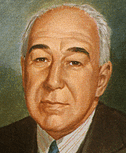
Edwin Joseph Cohn, was born in New York City in 1892, the son of Abraham and Maimie Einstein Cohn. His father was a highly successful tobacco merchant. The son battled against anti-semitism for most of his life. He received his PhD from the University of Chicago in 1917.
The entry of the United States into World War I interrupted this work, but it demonstrated to him the need for blood at the battlefront. Cohn returned to Harvard, to begin life as a protein chemist, working for many years with George R. Minot and W. P. Murphy on the liver extract that cures pernicious anemia. Cohn returned to the study of proteins around 1938. Then war in Europe, and the increasing imminence of American involvement, led him to concentrate on the separation of the many different proteins of blood plasma, for which there was urgent need in wartime medicine and surgery. Cohn envisaged a comprehensive process for this separation, with each protein to be available in concentrated form. The basis of the chemical procedure was the differential precipitation of the plasma proteins with ethyl alcohol at low temperature, with careful control of salt concentration, temperature, and acidity or alkalinity of the medium.
On December 8, 1941, 29 vials of albumin were dispatched from Boston to Honolulu. Cohn’s blood fractions saved thousands of soldiers in World War II. In 1949 he became Higgins University professor at Harvard. He continued to develop new techniques for fractionating blood plasma, for preserving red cells for transfusion, and for studying other constituents of blood.
In the early 1950s Dr. Cohn developed the first blood separator the Cohn Centrifuge Spectra derived from the De Laval cream separator but in 1953 he died of a stroke. For the previous 15 years he had suffered from severe hypertension, the consequence of an undiagnosed phaeochromocytoma.
In the last year of his life he established the Protein Foundation, later called the Center for Blood Research.
No comments:
Post a Comment